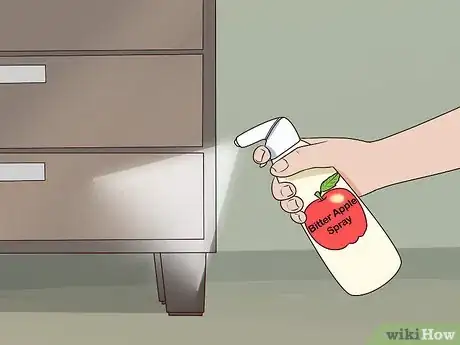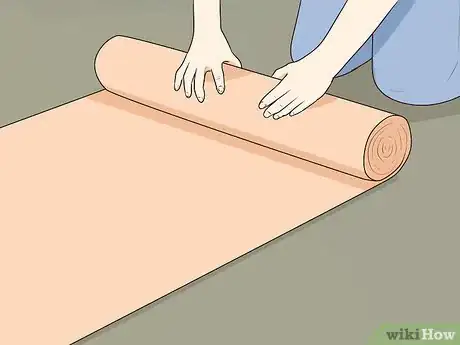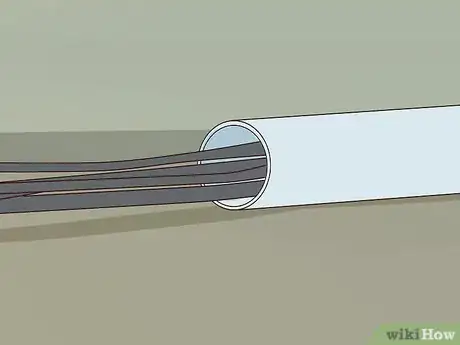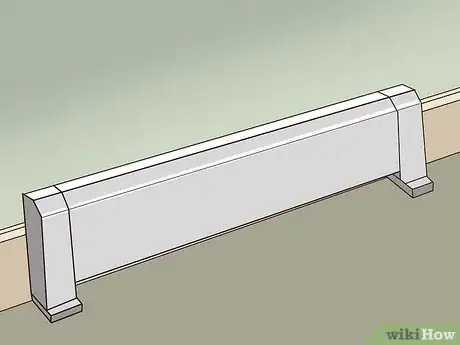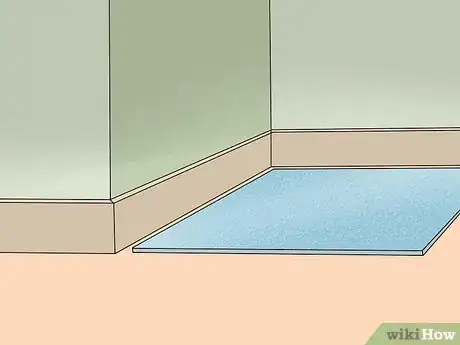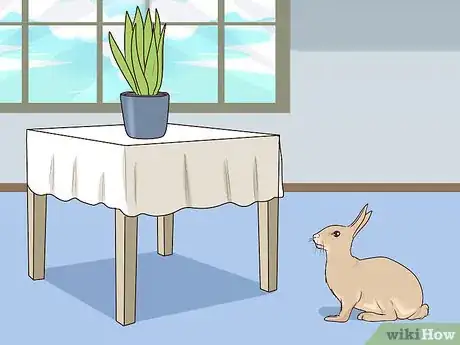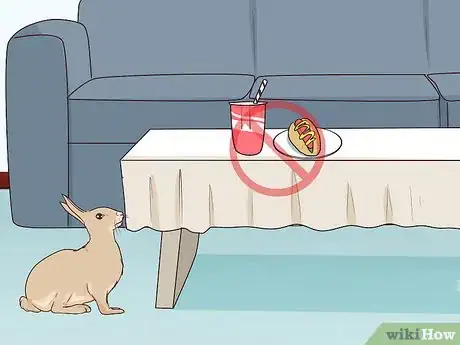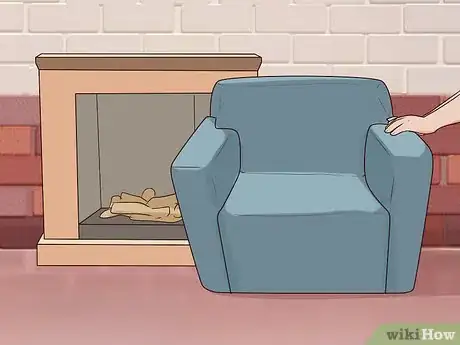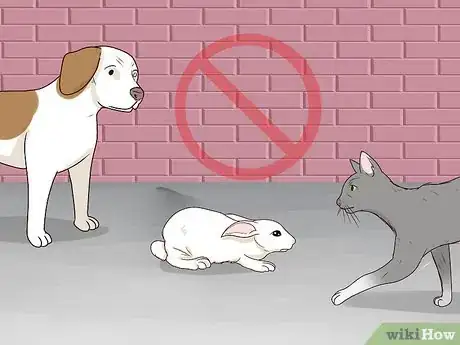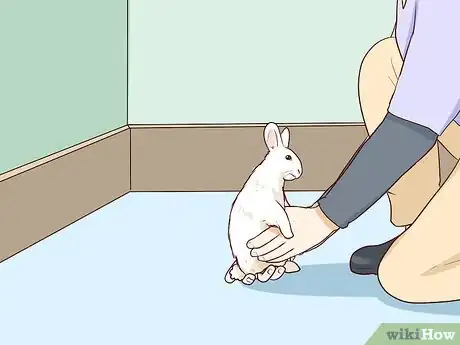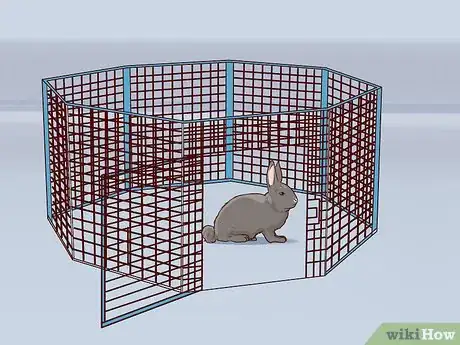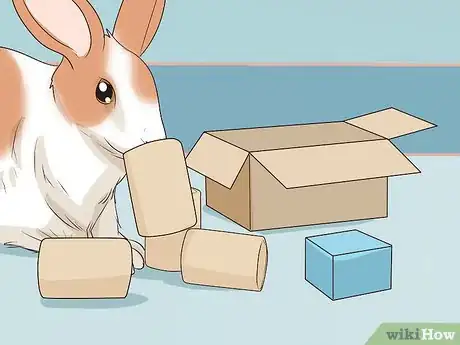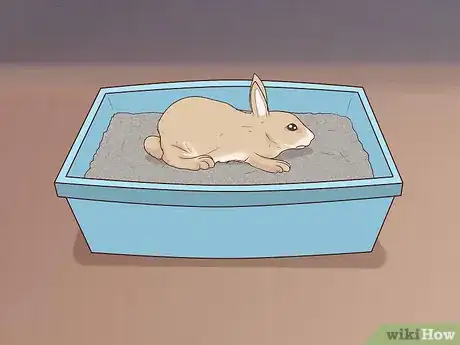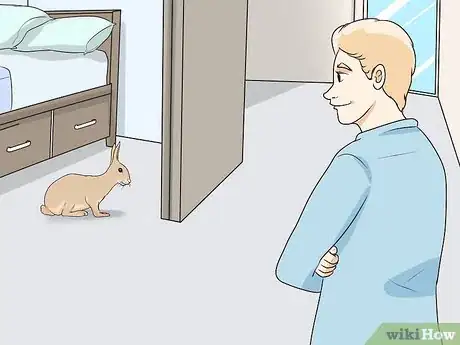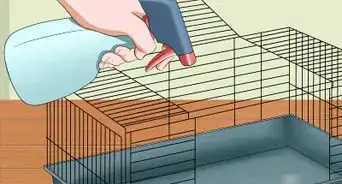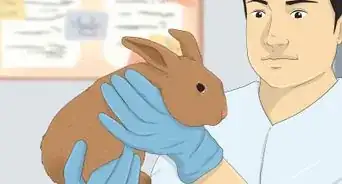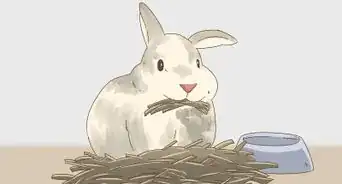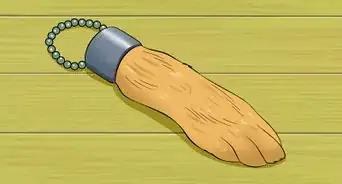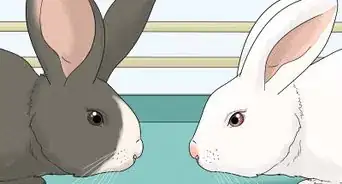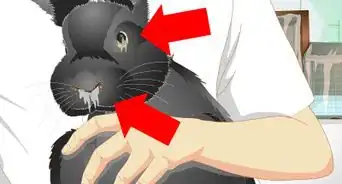This article was co-authored by Pippa Elliott, MRCVS. Dr. Elliott, BVMS, MRCVS is a veterinarian with over 30 years of experience in veterinary surgery and companion animal practice. She graduated from the University of Glasgow in 1987 with a degree in veterinary medicine and surgery. She has worked at the same animal clinic in her hometown for over 20 years.
There are 9 references cited in this article, which can be found at the bottom of the page.
This article has been viewed 54,227 times.
Letting your rabbit out of its enclosure and into your home is a great way to keep it entertained. Before you let your rabbit start exploring, minimize the damage that can be done by covering wooden objects, walls, carpets, wires, and keeping food and dangerous objects out of reach. You can also keep your rabbit and furnishings safe by confining your rabbit to a smaller area. If you are letting your rabbit roam freely around your home, make sure that you provide chew toys, bedding, and a litter box.
Steps
Minimizing the Potential Damage
-
1Spray wooden furniture with a bitter apple spray to deter chewing. Purchase bitter apple spray from a pet store and follow the directions on the bottle to apply it to your wooden furniture. You only need to apply the bitter apple spray to the lower parts of the furniture that your rabbit can reach. Bitter apple spray is safe to use with rabbits.[1]
- Bitter apple spray prevents rabbits from chewing as it has a bad flavor that your rabbit won’t like.
- While bitter apple spray is generally considered to be very effective against chewing, some rabbits do appear to like the taste. If the bitter apple spray doesn’t stop your rabbit from chewing, wrap chair and table legs with cardboard. This means that your rabbit will chew through the cardboard rather than the wood.
- Alternatively, you can place PVC tubing around wooden furniture legs. The PVC tubing will be too difficult for your rabbit to bite through.[2]
- It’s natural for rabbits to chew, so stopping all chewing activity may not be possible.
-
2Place plastic carpet runners under furniture to prevent nesting. Either select pre-cut plastic carpet runners or choose a roll that you can cut to size. Set a piece of plastic carpet runner under every piece of furniture that you cannot easily see under, but that your rabbit is able to fit under. Make sure that the spiked side is facing up as this will deter your rabbit from walking over it.[3]
- Plastic carpet runners are sheets of flexible plastic that are placed over the carpet to protect it. Normally, the spikes face down into the carpet to hold the runner in place.
- Rabbits love to nest in soft upholstery such as beds and couches, as these spaces are warm and dark, and feel secure.
- If you have a recliner, always check underneath before you put it down. If you are concerned about your rabbit being underneath the recliner, tightly stuff old blankets and towels in the space so that your rabbit cannot get in.
Advertisement -
3Use plastic tubing to protect exposed wires. Purchase plastic tubing that is approximately 1⁄2 in (1.3 cm) thick in diameter from a home improvement or electronics store. Feed the exposed wires through the tubing. Alternatively, tape the exposed wires up high and out of your rabbit’s reach.
- Plastic tubing is also called polygon tubing, plumber’s tubing, and vacuum tubing.[4]
- Make sure that you also check for exposed wires behind furniture and under beds, as your rabbit will be able to find these.
-
4Apply baseboard covers to protect the baseboards from being chewed. Choose plastic or untreated wooden baseboard covers from a home improvement store. Install these according to the manufacturer’s instructions or simply hold the baseboard covers up against the baseboards using objects such as bricks or furniture. Your rabbit may chew the covers, however, the actual baseboards will be protected.[5]
- If you want the baseboard covers to be able to be easily removed and reapplied, simply use hook-and-loop fasteners to attach them to the baseboards.
-
5Place a large tile on the carpet where your rabbit likes to chew. If you notice that your rabbit has a favorite chewing spot, simply cover it with a large tile. You can also use a plastic carpet runner to cover a larger area if you prefer. If possible, choose a room with low-pile carpet as this will be less tempting for your rabbit.[6]
- Alternatively, you can use a plastic office chair mat to cover a small area of the carpet.
- If you find that your rabbit is getting under carpets or mats, place bricks or large tiles in the corners. This prevents your rabbit from being able to burrow underneath.
-
6Place houseplants of reach to keep the plants and your rabbit safe. Rabbits love to chew on vegetation and will happily gnaw through an entire houseplant if they are left unattended. Make sure that all of your houseplants are either out of the room or high up on a surface where your rabbit cannot reach them. Many rabbit owners prefer to hang their plants from the ceiling instead.
- Ensure that you do not have any toxic plants in the same room as your rabbit. Even if the plants are hanging from the ceiling, the leaves can fall onto the ground.
- Plants that are toxic for rabbits include all plants that are grown from bulbs (such as tulips), many fruit and vegetable plants, and flowers such as foxglove, lupin, and larkspur.
-
7Keep food out of reach from your rabbit. Rabbits are able to jump onto tables and couches, so it is best that you keep all food out of the room while your rabbit is in there. If you do need to leave food in the room, make sure that you supervise your rabbit or that the food is in a plastic, storage container which your rabbit cannot get into.
-
8Block off stoves, fireplaces, and candles to protect your rabbit. Rabbits are very inquisitive creatures and may try to investigate dangerous objects such as stoves, candles, and fireplaces. Enclosure the fireplace to make sure that your rabbit stays away, keep your rabbit out of the kitchen while you use the stove, and place burning candles up high and out of reach.[7]
- Always keep your rabbit away from ashes, even if the ashes are cold. This is because the ashes can still be caustic.
-
9Keep other pets away from your rabbit while it's out. Cats and dogs naturally hunt rabbits, so it’s best to keep them away from each other. Even if your other pets are well-trained, keep them separated from your rabbit as your rabbit may feel frightened. Let your rabbit roam freely in one part of your home and your cat or dog roam freely in another.[8]
Confining Your Rabbit to One Area
-
1Choose the rooms in your home that your rabbit will have access to. Pick the rooms in your home that will be the easiest to rabbit proof. If possible, choose rooms that have limited or no carpet, baseboards, wooden furniture, and wires. Don’t choose a room such as an office where there are many exposed wires.[9]
- Many rabbit owners find that choosing just 1-2 rooms is ideal, as this is realistic and manageable to keep rabbit-proofed.
-
2Remove any wooden furniture and exposed wires if possible. Once you have chosen the rooms that your rabbit will have access to, it’s time to minimize the damage that can be done. Place any wooden furniture in another room if possible so that you don’t need to rabbit-proof it. Also, move electrical devices and appliances that have exposed wires to another room if possible.[10]
- If you need to keep wooden furniture or exposed wires in the room, don’t worry. These can be rabbit-proofed. However, know that these objects will still have the potential to be chewed.
-
3Install a baby gate to keep your rabbit contained in the room. Purchase a baby gate from a home improvement or baby store. Hold the baby gate in the doorway so that it rests flat on the ground. Then, adjust the screws on the side of the gate to change the width so that it fits in the doorway and is supported by the door frame. Follow the directions that come with the baby gate for additional instructions.[11]
- Choose a metal baby gate if possible. Avoid vinyl-covered or plastic baby gates as these are chewable.
- Simply move the baby gate to a different doorway if you want to move your rabbit to a different room.
-
4Use a puppy pen within the room if you have one. Set up the puppy pen in a place that doesn’t include any furniture or wires. Always supervise your rabbit while it is in the puppy pen to make sure that it doesn’t escape or get hurt.[12]
Letting Your Rabbit Explore
-
1Provide chew toys for your rabbit so that it has safe items to chew. By giving your rabbit safe objects to gnaw, it will be less likely to chew on furniture, walls, wires, and other less than ideal objects. Buy a selection of rabbit toys from a pet store or use wooden blocks, paper tubes, and cardboard boxes. Always have these objects available for to your rabbit to chew on.
- Chewing is a natural rabbit behavior. Rabbits will constantly chew throughout their lives as their teeth don’t stop growing and chewing helps to keep their teeth healthy.
-
2Give your rabbit bedding so that it has a comfortable place to sleep. Even if your rabbit is allowed to roam freely through your home, it still needs a dedicated place to sleep. Place a cardboard box or a rabbit hide box on the ground. Fill the box or hide with a layer of straw, shredded paper, or grass hay.[13]
- You can purchase rabbit hides and bedding from pet stores.
-
3Place a litter box on the floor for your rabbit to use. Get the same type of litter box that you would for a cat and fill it with approximately 1 in (2.5 cm) of non-clumping litter. Keep the litter box in a bathroom, utility room, or laundry to make cleaning out the box easier.
- Pine and cedar litters are toxic for rabbits.
-
4Supervise your rabbit as much as possible while it roams freely. Although rabbit-proofing largely minimizes the risks to your rabbit and home, your rabbit can still get into dangerous or unfavorable situations. Keep an eye on your rabbit while it is loose, especially if it is in a new or unfamiliar area.[14]
Warnings
- Take your rabbit to a veterinarian immediately if it shows any worrying symptoms such as seizures, a loss of appetite, lethargy, or a lack of body temperature regulation. These health issues can be caused by your rabbit consuming a toxic substance.[15]⧼thumbs_response⧽
Things You’ll Need
Minimizing the Potential Damage
- Bitter apple spray
- Cardboard or PVC tubing
- Plastic carpet runners
- Old blankets or towels
- Plastic tubing
- Baseboard covers
- Bricks or velcro
- Large tiles
Confining Your Rabbit to One Area
- Baby gate
- Puppy pen
Letting Your Rabbit Explore
- Chew toys
- Cardboard box or rabbit hide box
- Bedding
- Litter box
- Non-clumping litter
References
- ↑ https://bestfriends.org/resources/bunny-proofing-your-home
- ↑ https://www.longislandrabbitrescue.org/bunny-proofing.htm
- ↑ https://www.wideopenpets.com/everything-you-need-to-know-about-raising-a-free-roam-cage-free-bunny/
- ↑ https://bestfriends.org/resources/bunny-proofing-your-home
- ↑ https://www.longislandrabbitrescue.org/bunny-proofing.htm
- ↑ https://www.longislandrabbitrescue.org/bunny-proofing.htm
- ↑ https://rabbit.org/care/holidays.html
- ↑ https://www.petful.com/other-pets/pet-rabbit-care-guide/
- ↑ https://bestfriends.org/resources/bunny-proofing-your-home
- ↑ https://www.vetwest.com.au/pet-library/rabbit-housing
- ↑ https://www.longislandrabbitrescue.org/bunny-proofing.htm
- ↑ https://www.longislandrabbitrescue.org/bunny-proofing.htm
- ↑ https://kb.rspca.org.au/i-just-got-a-new-rabbit-can-you-give-me-some-general-advice-on-its-care_36.html
- ↑ https://www.longislandrabbitrescue.org/housing.htm
- ↑ https://www.petmd.com/rabbit/conditions/digestive/c_rb_poisoning
About This Article
To rabbit-proof your home, cover any wires with plastic tubing so your rabbit can't chew through them, or tape them up high so they're out of reach. Also, hide any houseplants so your rabbit can't chew on them since some plants are toxic to rabbits. You should also block off any fireplaces, stoves, and candles since flames and ashes are dangerous for rabbits. If you're worried about your rabbit chewing on wooden furniture, spray it with bitter apple spray. For more advice from our Veterinary co-author, like how to supervise your rabbit when it's exploring your home, scroll down!
